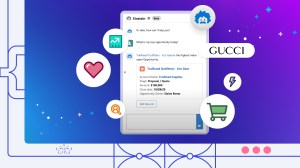Introducing Salesforce Customer 360 — Unify the Customer Experience on the World’s #1 CRM Platform
Customer 360 will provide a click-based admin interface to easily connect and manage customer data across Salesforce apps
With Customer 360 ID, companies will have a complete, up-to-date, contextually relevant profile of the customer
Pre-built Customer 360 packages for Service, Marketing and Commerce will enable companies to quickly create cross-channel customer experiences
SAN FRANCISCO—DREAMFORCE —September 25, 2018—Salesforce [NYSE: CRM], the global leader in CRM, today announced Salesforce Customer 360, a new way for companies to connect Salesforce apps and deliver unified cross-channel customer experiences. Core to Salesforce’s vision for the Customer Success Platform, Customer 360 will help companies move beyond an app- or department-specific view of each customer by making it easier to create a single, holistic customer profile to inform every interaction. By placing the customer at the center of the business, Customer 360 will enable companies to usher in dynamic new customer engagement models that bring together service, marketing, commerce and more in entirely new ways.
“As consumers, we know when a brand has gone the extra mile to deliver an amazing cross-channel experience, but creating that single view of the customer is extremely challenging for any company to do consistently,” said Bret Taylor, President and Chief Product Officer, Salesforce. “Customer 360 will make it easier for companies to bring service, commerce and marketing together to deliver the unified experiences that their customers demand — with clicks, not code.”
The Connected Experience Imperative
Seventy percent of customers say connected experiences — an engagement with a brand that reflects an understanding of past actions, product usage, and a host of other personalized factors — are very important to winning their business. They expect a consistent experience when connecting with a company, whether they are interacting with a service agent or shopping for a pair of shoes.
Despite this desire, disconnected experiences are an all too common occurrence — whether it’s the support agent who doesn’t have a historical view of previous purchases, an email marketing offer for the very same product that was purchased just hours before, or a service representative who instructs the customer to reach out through a separate channel for additional assistance because they don’t have all the relevant information at their fingertips.
These siloed experiences are equally frustrating for companies. Customer-facing employees lack a unified customer record, resulting in a fragmented view of each customer. Critical information that makes up a complete customer profile is spread across multiple systems. Traditional methods used to unify customer data and plug it back into engagement applications require extensive IT resources, and are difficult to change when organizations need to deliver new personalized customer experiences quickly.
Companies need a new way to empower their organizations to manage and create connected customers experiences that surface the right information to the right people at the right time.
Deliver a Unified Customer Experience with Salesforce Customer 360
Customer 360 comprises a set of powerful platform services that will enhance data management across Salesforce apps and provide instant access to consistent, reconciled customer data. These will include:
- Click-based UI for app and data management: This user interface will enable admins to establish trusted connections between Salesforce apps and orgs; map and reconcile data across clouds; and create a canonical data model that provides a single representation of customer data for connected systems. Previously companies would have to rely on point-to-point connections, but with these capabilities companies will have a straightforward, secure way to connect their customer data and one single place to view their Salesforce apps.
- Reconciled 360 ID and profile across apps: A single ID will enable Salesforce apps to recognize a customer across multiple channels regardless of how they identify themselves — name, email, phone number, social media handle, etc. Data management capabilities prepare, match, reconcile and update the customer profile across clouds, and data exchange features enable employees to pull up the right customer data exactly when needed, such as when a service agent may need to pull a list of past purchases a customer has made so they can better assist in solving a problem. Unlike massive data lakes or data warehouses that can become costly and slow businesses down, Customer 360 leaves data in the source where it originated, retrieving it only when needed.
- Pre-built packages for Service, Marketing and Commerce: These packages will let companies quickly deploy experiences for the most common use cases, such as a Service Cloud experience that enables agents to see purchase and browse history from Commerce Cloud, or a Marketing Cloud journey that is automatically triggered by an event in Commerce Cloud. Each package will have the necessary components to accelerate the delivery of connected experiences. In Service Cloud, components will have pre-built connectivity to Customer 360. In Marketing Cloud, pre-built journey and email templates will contain content and data sourced directly from Customer 360. And Commerce Cloud data and events will be distributed to every system connected to Customer 360.
The concept of the single customer view is not new, but how Salesforce will deliver that view is. Customer 360 will handle data in the most efficient, secure way, letting it reside in the systems that manage it and calling upon it when needed, rather than creating massive centralized lakes of duplicate data. Now companies will be able to focus less on data management and more on delivering truly unified cross-channel experiences. For example, if a customer of an apparel company fills up their cart with merchandise while on a Commerce Cloud-powered website and then abandons it, this event could automatically trigger an action, adding them into a campaign in Marketing Cloud offering discounts on those products abandoned in their cart. Or, if an ecommerce retail customer reaches out to support about changing an order, an agent using Service Cloud would have access to all past purchases the customer made through a Commerce Cloud-powered website.
Extend the Power of Customer 360 with MuleSoft Anypoint Platform
Customer 360 will unify Service, Marketing and Commerce, but to obtain a more complete view of the customer, companies must access customer data from a number of systems outside Salesforce. To accomplish this, Salesforce customers will be able to implement API-led connectivity across any application, data, or device with MuleSoft Anypoint Platform™ and then connect these APIs directly to Customer 360, creating a truly complete customer view. With MuleSoft and Customer 360, Salesforce customers can realize their vision for digital transformation with the ability to connect with and understand their customers in entirely new ways.
Comments on the news:
- “One of Crocs’ core values is ‘people-purposed design,’ which not only applies to the products we make but also to the experiences we create for our customers,” said Harvey Bierman, VP eCommerce Technology & Operations at Crocs, Inc. “Salesforce has been a key partner in helping us create compelling customer experiences throughout our digital footprint, which is one of the key drivers of ecommerce growth around the world for our brand.”
- “Connecting customer data across a large organization can typically involve months of expensive development work, and often the final solution falls short of what was needed,” said Sheryl Kingstone, Research Vice President, Customer Experience & Commerce, 451 Research. “Salesforce is hoping to change that with Customer 360 by making it possible for admins to connect internal customer data across the organization. If done right, this could significantly reduce development costs, and help companies unlock and create new value from this unified customer data.”
Dreamforce 2018
Dreamforce 2018 is four days of innovation, inspiration & learning, equality, giving back and fun for the Salesforce Community. More than 10 million viewers will join online and 171,000 Trailblazers are registered to attend in person for the sold out event. Dreamforce will feature 2,700+ sessions to help every role in every industry succeed along with opportunities to get hands on Salesforce’s latest product innovations. Every year the world’s most innovative minds come to Dreamforce to inspire, excite and motivate attendees. To learn more, please visit: https://www.salesforce.com/dreamforce/
Additional Information
- For general information on Customer 360, please visit: https://www.salesforce.com/solutions/customer-360/
- Learn more product details in this blog post:https://www.salesforce.com/blog/2018/09/what-is-salesforce-customer-360.html
- Learn more about how Customer 360 came to be in this Q&A with Patrick Stokes, SVP of Product Management: https://www.salesforce.com/company/news-press/stories/2018/9/092518-q/
- Hear about Crocs’ journey with Customer 360 here: https://www.salesforce.com/blog/2018/09/crocs-customer-360.html
Pricing and Availability
- Customer 360 is in pilot today and will be generally available in 2019.
- Customer 360 will be included with related Salesforce products. Additional details will follow as we approach GA.
About Salesforce
Salesforce helps organizations of any size reimagine their business with AI. Agentforce — the first digital labor solution for enterprises — seamlessly integrates with Customer 360 applications, Data Cloud, and Einstein AI to create a limitless workforce, bringing humans and agents together to deliver customer success on a single, trusted platform. Visit www.salesforce.com for more information.













